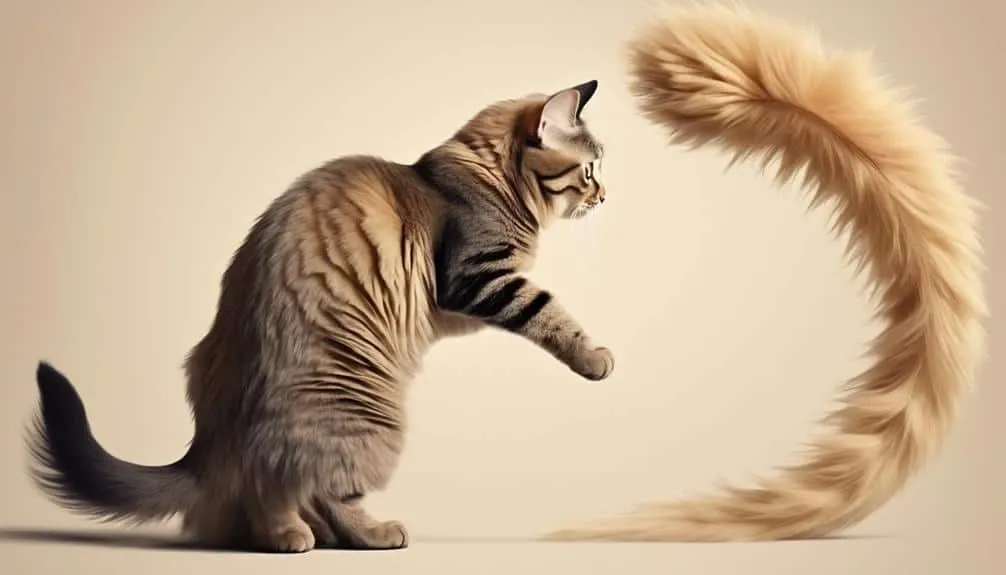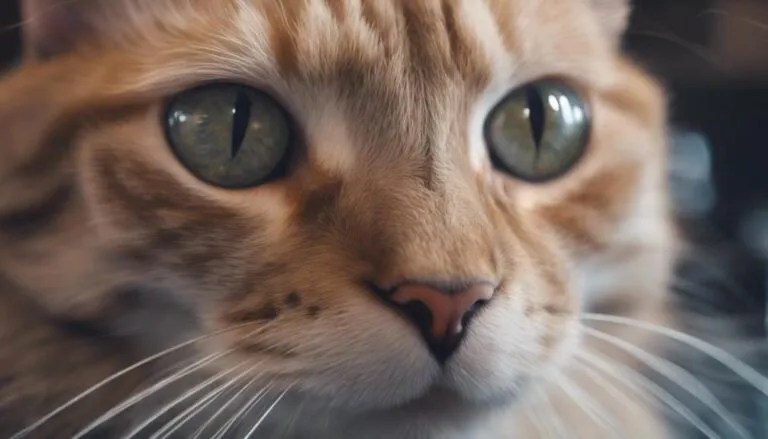The Best Fluffy Pancakes recipe you will fall in love with. Full of tips and tricks to help you make the best pancakes.

With their tails held high, swaying gracefully like a delicate pendulum, cats possess a secret language that lies within this seemingly ordinary appendage.
But what lies beneath the surface of a cat's tail? Why can something as simple as touching it be a risky proposition?
In this discussion, we will unveil the mysteries behind a cat's tail, exploring its multifunctional role in their physical prowess and communication. However, be prepared to discover the hidden sensitivities and potential risks that come with attempting to interact with this enigmatic feline feature.
Key Takeaways
- Cats use their tails for balance, agility, and communication.
- The tail is a sensitive and vulnerable area for cats.
- Cats may not like their tails touched due to trust issues, personal preference, or survival instincts.
- Some cats may allow tail touching as a sign of trust and vulnerability.
Function and Communication of a Cat's Tail
The cat's tail serves multiple functions, including providing balance, agility, and communication through visual signals.
Cats rely on their tails for maintaining balance when walking on narrow surfaces and for adjusting their body position while falling, ensuring they land on their feet.
Beyond its physical functions, the tail is also an essential tool for communication. Cats use tail language, using different positions and movements to convey their moods and intentions. Understanding tail language is crucial in interpreting a cat's behavior and ensuring their wellbeing.
Additionally, the tail is highly sensitive because it's an extension of the spinal cord. Neurons in the tail transmit information to the cat's brain, while sensory nerves in the tail send signals of pain, touch, temperature, and other sensations. This high sensitivity explains why cats may react strongly to tail touching, as it can evoke intense responses compared to other areas of their body.
Sensitivity and Feeling in a Cat's Tail
Cats' tails possess a remarkable level of sensitivity, making them a crucial part of their sensory system. The tail isn't just a decorative appendage; it plays a vital role in a cat's balance, agility, and communication.
Cat tail anatomy reveals that it consists of bones, muscles, and nerves intricately intertwined. The tail's sensitivity stems from its connection to the spinal cord, with neurons transmitting information to the brain. Sensory nerves within the tail allow cats to perceive pain, touch, and temperature.
Due to their heightened sensitivity, cats often react strongly to tail touching, displaying discomfort or even aggression. It's important to handle a cat's tail gently and with caution to avoid any potential tail injuries, such as trauma or fractures.
Reasons Cats Don't Like Their Tails Touched
Touching a cat's tail can be risky due to its sensitivity and the potential for causing stress or discomfort. Cats have a high level of sensitivity in their tail, which is a result of it being part of the spinal cord. The tail contains numerous nerves and sensory receptors that transmit information to the cat's brain. When the tail is touched, it can evoke a stronger response compared to other areas of the body.
Many nerves, muscles, and small bones are intertwined in the tail, making it a sensitive and vulnerable area for cats. This sensitivity and vulnerability can cause cats to feel unsafe and stressed when their tails are touched. Additionally, approaching the tail can be perceived as a threat, triggering a defensive reaction.
Therefore, it's important to respect a cat's boundaries and avoid touching their tail if they show signs of discomfort or stress. Understanding and respecting a cat's tail sensitivity can have a positive impact on their behavior and overall well-being.
Reasons Cats May Not Like Their Tails Touched
When considering the reasons why cats may not enjoy having their tails touched, it's important to recognize the various factors that contribute to their discomfort and preferences.
- Tail sensitivity and injury: Cats may have experienced past injuries to their tails, such as trauma or fractures, which can make them sensitive to touch.
- Trust issues and personal preference: Some cats may not trust their owners or other individuals enough to allow tail touching. Additionally, like humans, cats have personal preferences when it comes to physical contact, and some simply don't enjoy having their tails touched.
- Survival instincts: Cats may instinctively be protective of their tails as they're a vulnerable body part.
Understanding these reasons can help cat owners respect their furry friends' boundaries and build a trusting relationship based on their individual preferences and comfort levels.
Exceptions and Determining if Your Cat Likes Tail Touching
How can you determine if your cat enjoys having its tail touched?
While many cats may not appreciate tail touching, there are exceptions. Trust and vulnerability play a crucial role in determining if a cat likes tail touching. Some cats allow it as a sign of trust and openness.
Additionally, cats have unique preferences when it comes to petting, including tail stroking. Observing your cat's reactions and body language can help you understand if they enjoy tail touching. Look for indicators such as changes in mood, tail position, tail motion, and the context in which the interaction takes place.
Tail and body language can reveal if your cat is happy, fearful, anxious, or aggressive. By paying close attention, you can better understand your cat's individual preferences and build a stronger bond based on trust and mutual understanding.
Observing Mood and Body Language Indicators
To understand if your cat enjoys having its tail touched, it's important to observe its mood and body language indicators. Understanding a cat's tail language and reading its body cues can provide valuable insight into their feelings and preferences. Here are three key indicators to look for:
- Tail position: A relaxed and raised tail indicates a content and friendly cat, while a tucked or lowered tail suggests fear or anxiety.
- Tail motion: A slow and gentle wag or swish of the tail often signifies a calm and happy cat. However, rapid or aggressive tail movements may indicate aggression or irritation.
- Overall body language: Pay attention to your cat's posture, ear position, and facial expressions. A relaxed body, forward-facing ears, and soft eyes indicate a positive mood, while a hunched posture, flattened ears, and dilated pupils may signal discomfort or aggression.
Tips for Safe and Enjoyable Tail Interaction
Now that you have a better understanding of a cat's mood and body language indicators, let's explore some tips for safely and enjoyably interacting with your cat's tail.
Tail handling techniques are essential for building trust with tail interactions. First and foremost, it's crucial to approach the cat with gentleness and respect. Avoid sudden movements or grabbing the tail, as this may startle or agitate the cat. Instead, allow the cat to approach you and initiate tail interaction.
Begin by offering gentle strokes at the base of the tail, gradually moving towards the tip if the cat remains relaxed and receptive. Pay attention to the cat's body language throughout the interaction, looking for signs of discomfort or tension.
If the cat shows any signs of distress, such as twitching or lashing the tail, it's best to discontinue the interaction and give the cat space. Remember, building trust takes time, so be patient and understanding with your cat's boundaries and preferences.
Frequently Asked Questions
Can Tail Touching Cause Physical Harm to a Cat?
Yes, tail touching can cause physical harm to a cat. The tail is a sensitive area with nerves, muscles, and small bones. Cats can be protective of their tails, and touching it can cause stress and make them feel unsafe.
How Can Tail Touching Affect a Cat's Mood?
Understanding a cat's body language is crucial when it comes to tail touching. It can affect their mood negatively if they feel threatened or unsafe. Exploring alternative ways to interact with cats that respect their boundaries and preferences is important.
Are There Any Specific Signs That Indicate a Cat Does Not Want Their Tail Touched?
Signs of tail discomfort in cats include twitching, swishing, or tucking it tightly. Understanding the importance of tail language in cat communication is crucial. Pay attention to a cat's body language and respect their boundaries to maintain a positive relationship.
Can Tail Sensitivity Be a Sign of a Medical Condition?
Yes, tail sensitivity can be a sign of a medical condition in cats. It could indicate an injury, nerve damage, or an underlying issue. A veterinarian should be consulted to determine the cause and provide appropriate treatment.
Are There Any Techniques or Approaches That Can Help a Cat Feel More Comfortable With Tail Touching?
Techniques for gradual desensitization and positive reinforcement training can help a cat feel more comfortable with tail touching. By slowly introducing touch and rewarding positive behavior, the cat can learn to associate tail touching with positive experiences.
Conclusion
In conclusion, a cat's tail isn't just a mere appendage but a complex tool for balance, communication, and self-preservation. Its sensitivity and vulnerability make touching a cat's tail a risky endeavor, potentially triggering defensive reactions and stress.
By understanding a cat's body language and respecting their boundaries, we can foster a better relationship with our feline companions. Remember, a cat's tail is like a delicate instrument, and treating it with care and caution will ensure safe and enjoyable interactions for both cat and human.








